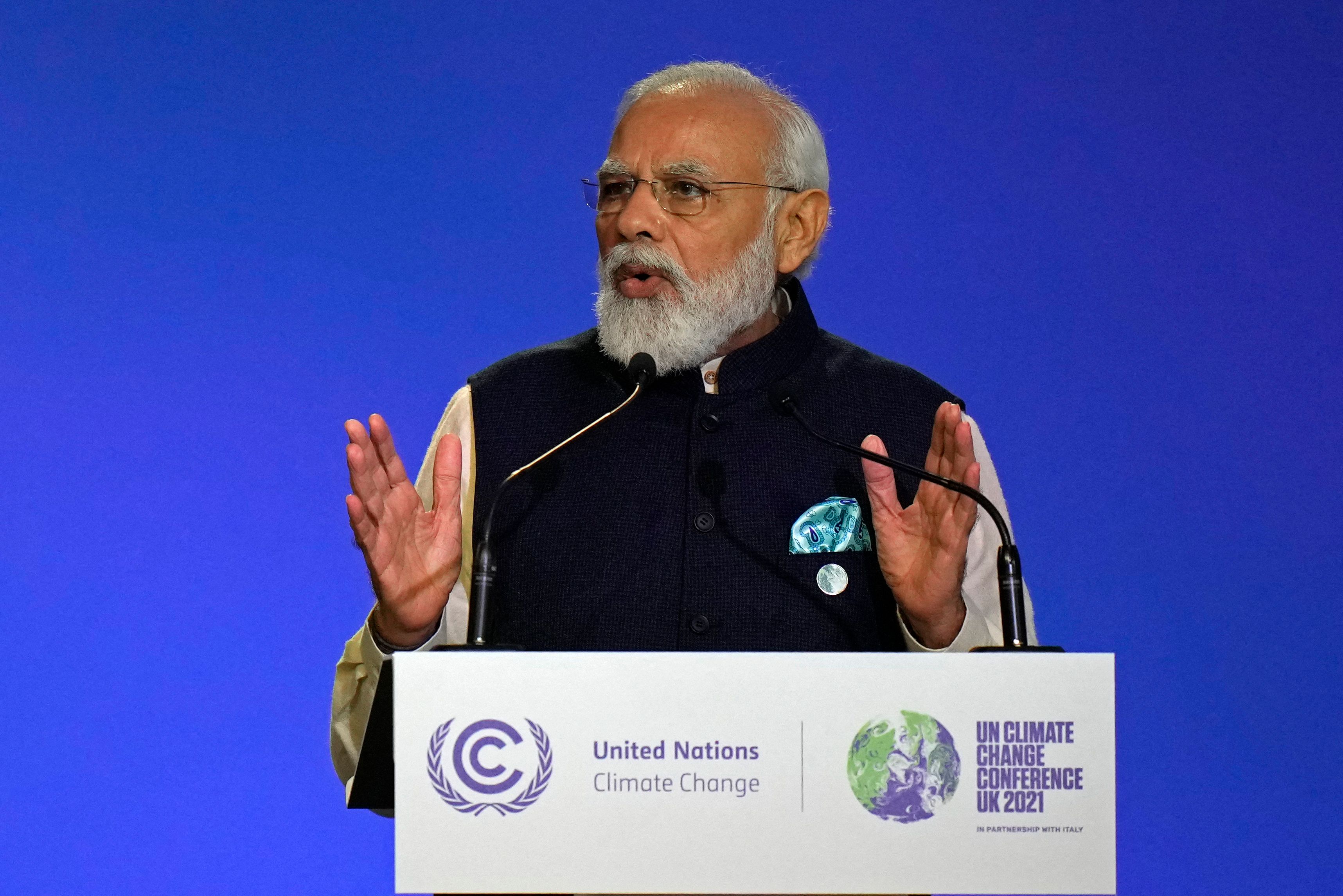India's 2070 net-zero goal a 'big' and 'bold' step to some but 'too late' for others
Sign up now: Get insights on Asia's fast-moving developments

Prime Minister Narendra Modi made the pledge as one of India's five commitments.
PHOTO: AFP
Follow topic:
NEW DELHI - India's surprise announcement of a net-zero emissions target for 2070 at the ongoing COP26 meet in Glasgow has been described as a bold and big step by climate policy and energy experts, although some critics termed it as too late.
Prime Minister Narendra Modi made the pledge as one of India's five commitments, which included a promise to secure half of the country's energy needs from renewable resources by 2030. India also plans to reduce its total projected carbon emissions by one billion tonnes by the same year.
China, Saudi Arabia and Russia have announced plans to attain their net-zero targets by 2060, while the United States and the European Union aim to hit theirs a decade earlier.
A net-zero target refers to the deadline by which a country's total emissions are offset by the absorption of carbon dioxide in the atmosphere, relying on carbon sinks such as forests as well as nascent technologies. Reducing net emissions to zero is necessary to stabilise global temperatures.
India is the world's fourth-biggest emitter of carbon dioxide after China, the United States and the European Union but its per capita emissions are much lower. It constitutes around 17 per cent of the world's population, while contributing only 5 per cent of global emissions.
The country's net-zero goal comes less than a week after Indian officials publicly rejected calls to announce such a target amid concerns of inadequate financial and technological help from developed countries for this to happen.
Given this context, Mr Siddharth Singh, an independent climate policy and energy analyst, welcomed the announcement as a "very big and welcome piece of news". He told The Straits Times: "This will help India plan for the interim five years and 10 years much better because when you have a long-term target, it just helps bring together the short-term policies in place more effectively."
Dr Arunabha Ghosh, the CEO of Council on Energy, Environment and Water, a Delhi-based think tank, described India's aims for 2070 as a bold statement that is "equitable and consistent with climate justice".
"Yet, it is far more aggressive actually than developed countries because it is going to be a much faster transition from peaking of emissions to net zero," he told ST on the phone from Glasgow, where he is attending the COP26 meet. India's emissions are expected to peak around 2045, and the country has set a target to achieve net zero 25 years after that.
In contrast, countries such as the US and the UK, as well as the EU, have had a long runway since the peak of their emissions to set their path for their respective net-zero goals. Emissions in the US peaked in 2005, and in the 1970s in the UK and the EU. All three have given themselves more than four decades to to achieve their net zero target by 2050.
India's commitment to a net-zero transition has to now be backed up by a supportive domestic regulatory ecosystem as well as reliance on new technologies, such as those to reduce emissions and absorb atmospheric carbon.
In addition to legal backing for its stated goals so that governments in India, including future ones, are held to account, there is greater need for green financing. "The goals have been set, the policy has been set. Now the investment has to flow and investment will not only come from India, it has to come from overseas as well," said Dr Ghosh.
India plans to increase its non-fossil energy capacity to 500GW by 2030, which is considerably more than its current total energy generation capacity of around 388GW. While speaking in Glasgow, Mr Modi said India expects the developed countries to provide US$1 trillion (S$1.35 trillion) in climate finance, far more than the US$100 billion promised to developing countries but yet to be delivered.
A recent analysis by the International Energy Agency, which factored in a path for India to net zero by the mid-2060s, stated that clean energy investments would have to jump from about US$30 billion to US$160 billion by 2030.
Mr Singh said that the 2070 net-zero target is both a "risk and an opportunity" for India with much depending on how green technologies evolve in developed countries. If advanced economies are able to invest and demonstrate that transitions are possible, there will be spillover effects allowing developing countries such as India to catch up.
"The 2070 target is not set in stone. It is just a target into the distance that you're walking towards. You could go faster, you could go slow. It really depends on what happens in the interim," he added.

India has been exploring the use of new technologies that could help reduce emissions, including a National Hydrogen Mission that was announced in August 2021. "We are looking at the fuels of the future that will drive our factories, heavy industries and long-distance transport," added Dr Ghosh. "So the policy framework, the investment framework and bets on new technologies - all of these have to now be there to back up these commitments."
Meanwhile, Greenpeace India has said the announcement for a net-zero emission by 2070 is "the right direction of travel" but added that India should actively strive for an earlier date of zero emissions after reassessing the situation in the coming years.
"The next 10 years are going to be crucial in achieving the climate target. The action plan must start reducing emissions at the sources as fast and as much as possible," it said in a statement.

